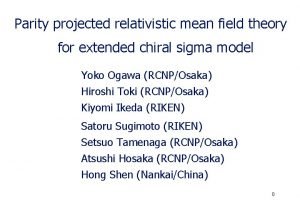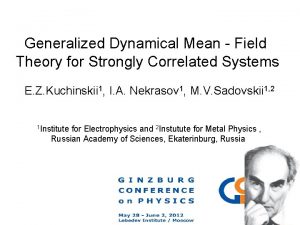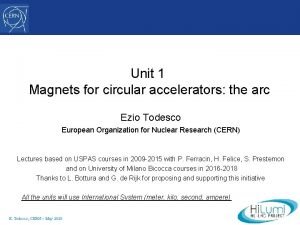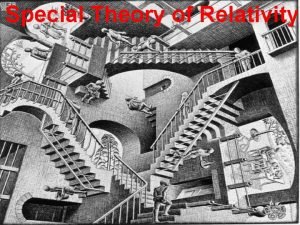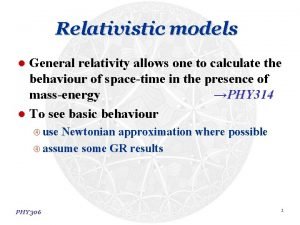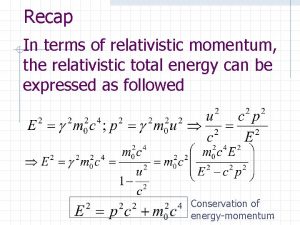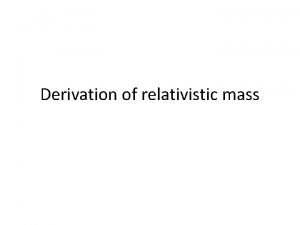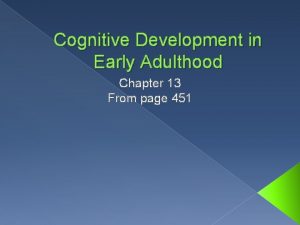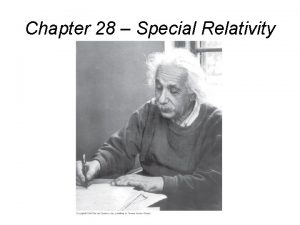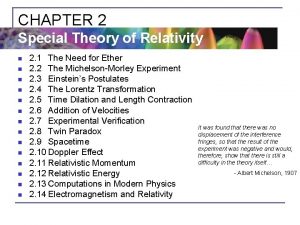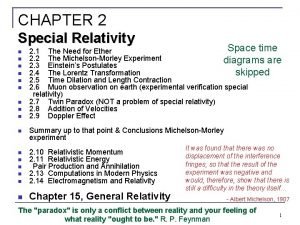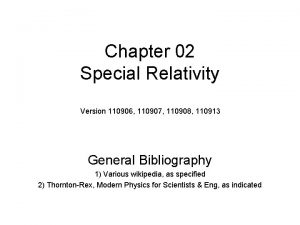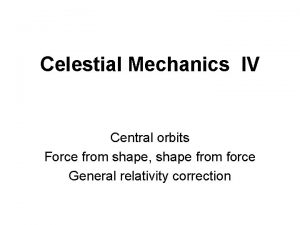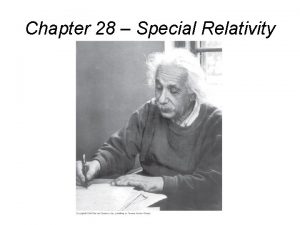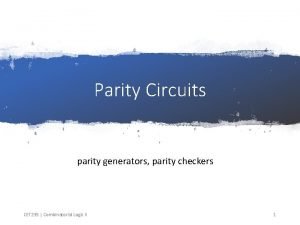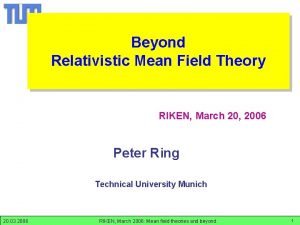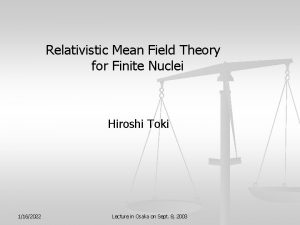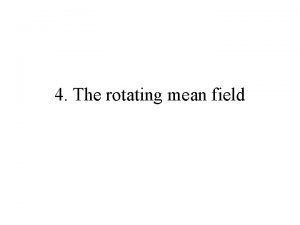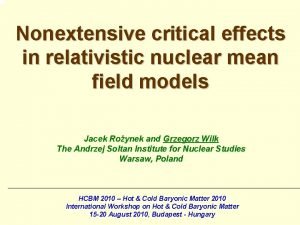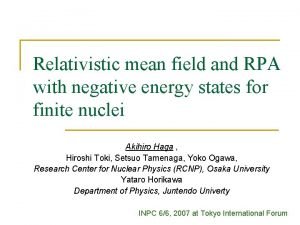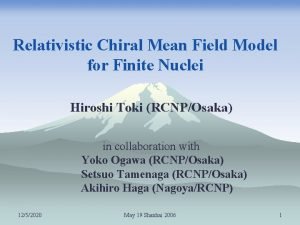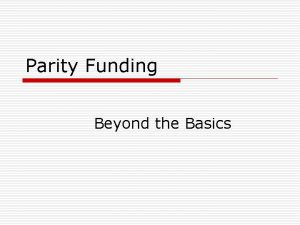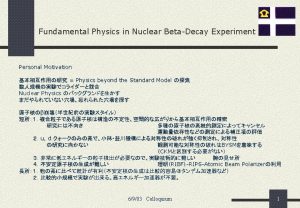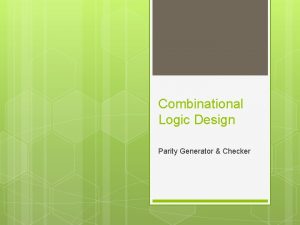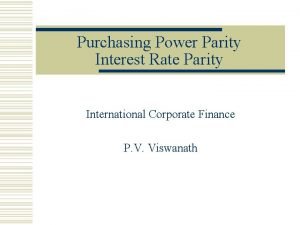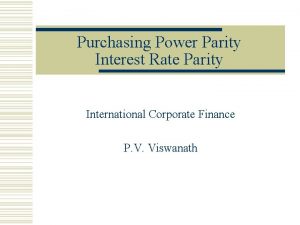Parity projected relativistic mean field theory for extended

















- Slides: 17

Parity projected relativistic mean field theory for extended chiral sigma model Yoko Ogawa (RCNP/Osaka) Hiroshi Toki (RCNP/Osaka) Kiyomi Ikeda (RIKEN) Satoru Sugimoto (RIKEN) Setsuo Tamenaga (RCNP/Osaka) Atsushi Hosaka (RCNP/Osaka) Hong Shen (Nankai/China) 0

Introduction The purpose of this study is to understand the properties of finite nuclei by using a chiral sigma model with pion mean field within the relativistic mean field theory. Chiral symmetry : Linear sigma model in hadron physics M. Gell-Mann and M. Levy, Nuovo Cimento 16(1960)705. Pion : Mediator of the nuclear force H. Yukawa, Proc. Phys. -Math. Soc. Jpn. , 17(1935)48. Spontaneous chiral symmetry breaking Y. Nambu and G. Jona-Lasinio, Phys. Rev. 122(1961)345. Toki, Sugimoto and Ikeda demonstrate the occurrence of surface pion condensation. Prog. Theor. Phys. 108 (2002) 903. Application of extended chiral sigma model for finite nuclei(N=Z even-even). Prog. Theor. Phys. 111(2004) 75. Contents Problem of now framework Parity projection Parity projected relativistic Hartree equations Summary 1

Lagrangian Linear Sigma Model 2

Extended Chiral Sigma Model Lagrangian(ECS) Dynamical mass generation term for omega meson J. Boguta, Phys. Lett. 120 B(1983)34 Non- linear realization New nucleon field 3

Mean Field Equation Dirac equation Parity mixed single particle wave function Klein-Gordon equations 4

Character of the ECS model in nuclear matter Large incompressibility K = 650 Me. V Small LS-force ECS TM 1(RMF) Effective mass : M* = M + gss, Hadron property M = 939 Me. V mp = 139 Me. V Free parameter ms = 777 Me. V gw =7. 0337 mw = 783 Me. V fp = 93 Me. V m*w = mw + g~ws ~ 80 % gs = M / fp = 10. 0968 ~ gw = mw / fp = 8. 41935 Saturation property E/A-M = -16. 14 Me. V r = 0. 1414 fm-3 Non-linear coupling l= (ms 2 - mp 2) / 2 fp 2 5 = 33. 7847

Finite Nuclei ECS model (with pion) ECS model (without pion) TM 1(RMF) Y. Ogawa, H. Toki, S. Tamenaga, H. Shen, A. Hosaka, S. Sugimoto and K. Ikeda, Prog. Theor. Phys. Vol. 111, No. 1, 75 (2004) 6

Single Particle Spectrum N = 18 Without pion With pion Large incompressibility It is hard energetically to change a density. The state with large L bounds deeper. Anomalous pushed up 1 s-state. 7

The Problem and improvement of framework The magic number appears at N = 18 instead of N = 20. Large incompressibility Anomalous pushed up 1 s 1/2 state The effect of Dirac sea Parity projection We use the parity mixing intrinsic state in order to treat the pion mean field in the mean field theory because of the pseudovector(scalar) character of pion. We need to restore the parity symmetry and the variation after projection. 8

Parity Projection Single particle wave function Total wave function 1 h-state 1 p-1 h 2 p-2 h 2 h-state 0+ 09 H. Toki, S. Sugimoto, K. Ikeda, Prog. Theor. Phys. 108 (2002) 903.

N. Kaiser, S. Fritsch, W. Weise, Nucl. Phys. A 697(2002)255 2 p-2 h K = 255 Me. V p 0 - 0 - Experiment _ 25 Me. V K = 250 + 10

g 7/2 Fermi surface In 56 Ni case the j-upper state is Fermi level. 56 Ni 40 Ca On the other hand, in 40 Ca case the j-upper state is far from Fermi level. p 0 - 011

Hamiltonian density 12

Total energy Parity projected wave function Creation operator for nucleon in a parity projected state a Field operator for nucleon 13

Parity-projected relativistic mean field equations Variation after projection Nucleon part 14

Meson part We solve these self-consistent equations by using imaginary time step method. 15

Summary We show the problem in now framework of ECS model. Large incompressibility. Magic number at N = 20. We derive the parity projected relativistic Hartree equations. Difficulties of relativistic treatment Total energy minimum variation condition gives difficulty to the relativistic treatment, because the relativistic theory involves the negative energy states. We avoid this problem due to elimination of lower component. We however treat the equation which is mathematically equal to the Dirac equation. P. G. reinhard, M. Rufa, J. Maruhn, W. Greiner, J. Friedrich, Z. Phys. A 323, (1986)13. K. T. R. Davies, H. Flocard, S. Krieger, M. s. Weiss, Nucl. Phys. A 342 (1980)111. Magic number at N = 20 ? Prediction of 0 - state 16
 Relativistic mean field theory
Relativistic mean field theory Non projected visual
Non projected visual Dynamical mean-field theory
Dynamical mean-field theory Relativistic circular motion
Relativistic circular motion Relativistic thinking example
Relativistic thinking example Length contraction
Length contraction Bertrand postulate
Bertrand postulate Relativistic acceleration calculator
Relativistic acceleration calculator Relativistic momentum
Relativistic momentum Relativistic thinking example
Relativistic thinking example Relativistic mass derivation
Relativistic mass derivation Commitment within relativistic thinking
Commitment within relativistic thinking Relativistic kinetic energy
Relativistic kinetic energy Relativistic kinetic energy
Relativistic kinetic energy Rest energy of a proton
Rest energy of a proton Relative speed of approach
Relative speed of approach Relativistic equations of binet
Relativistic equations of binet Relativistic kinetic energy
Relativistic kinetic energy
